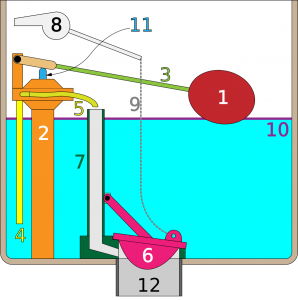 (412) 364-9114
(412) 364-9114
A hissing toilet is not at all uncommon and is usually an indication that water is leaking from the tank into the toilet bowl. In many cases, the hissing noise is related to an issue with the parts inside the toilet tank, known as the flush valve assembly. Fortunately, many homeowners are able to fix issues with the flush valve assembly on their own without the help of a handyman or a plumber.

When your toilet flushes, water empties out of the tank and into the bowl, then the tank fills again. The fill valve is what stops the water that is filling the tank when the water has reached the appropriate level. Sometimes, when the fill valve is not appropriately calibrated, the tank over-fills and water flows from the overflow tube into the toilet bowl.
Sometimes this problem can be fixed by adjusting the fill valve. To adjust the fill valve, start by lifting the lid off the toilet tank. The fill valve will look like a plastic buoy or a ball-cock floating on the surface of the water. If the fill valve is adjusted to a level above the overflow tube, the system will not shut off when the tank fills, and water will drain continuously.
Fill Valve Adjustment: The fill valve will be attached to a clip that controls the height of the valve. To adjust the height of the valve, adjust the clip so the base of the fill valve rests below the top of the overflow tube.
Ball-Cock Adjustment: In the case of the ball-cock supply valve system, adjust the screws at the top of the assembly with a screw driver until the ball-cock lowers and the water level drops below the top of the overflow tube.
If water is not reaching the toilet bowl through the overflow tube, then it may be leaking into the bowl through the flap valve, located at the bottom of the toilet tank. When the toilet flushes, the flap valve lifts up and water fills rushes out of the tank and into the bowl. The flap valve may be made of rubber or hard plastic, but either way, the will valve seal the toilet tank shut with a rubbery washer on its underside. After many years in a wet toilet, this rubber washer will become cracked and brittle, allowing water to leak out of the tank and into the bowl.
In some cases, cleaning the flap valve will fix the problem.
If the flap valve is clearly old and deteriorated, and cleaning it doesn’t help, the next step is to replace the valve altogether. Flap valves are sold in home improvement stores and are often easy to replace.
When all else fails, the next option is to replace the entire flush-valve assembly. Universal flush-valve assemblies are sold at home improvement stores for a low cost. These flush-valve assemblies often come with easy to follow picture-based instructions, so that most people with limited plumbing knowledge are able to replace their own toilet tank parts.
If none of these suggestions works, you could be facing a more serious problem. In this case, call a plumber you can trust and explain your issue.
You have this handy, numbered diagram in your article and yet you never refer to it. For example, is #1 the ballcock?
Mine was hissing, thought I was going to have to replace the whole flush assembly. I man, also shopping ( retired plumber) ask what I was trying to fix. Since I had a fluidmaster, he suggested I try replacing the fill valve seal first. Showed me how to get it apart. THAT WAS IT! A $3 fix. Thank you Paul!
I replaced the seal and it stopped the leak but it started to make a sound similar to air thru a tiny hole.